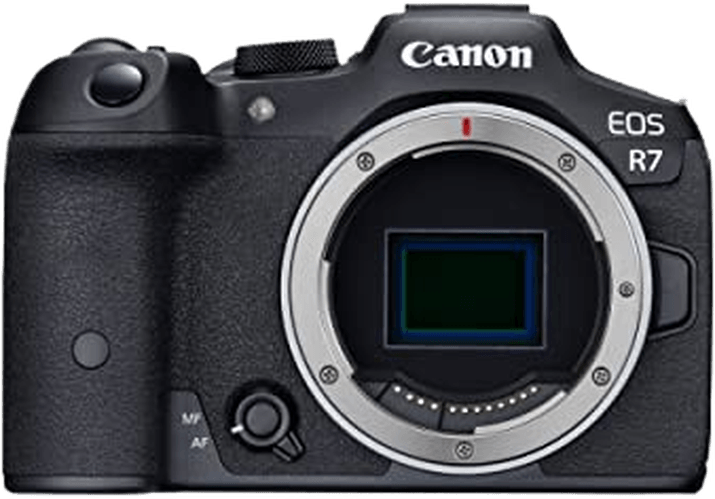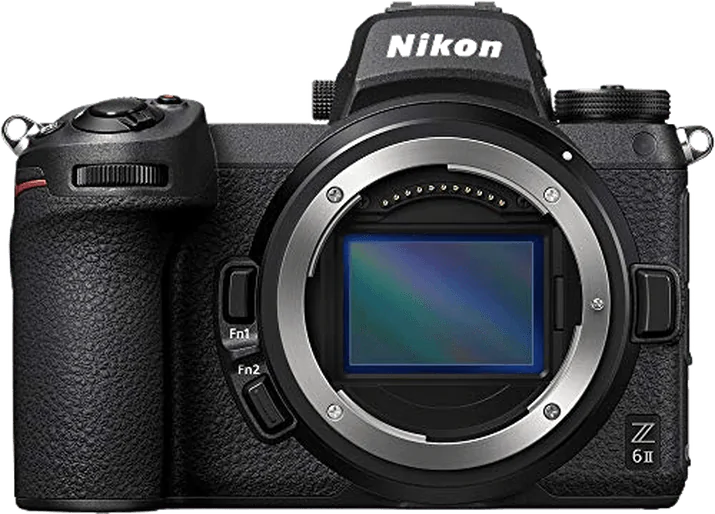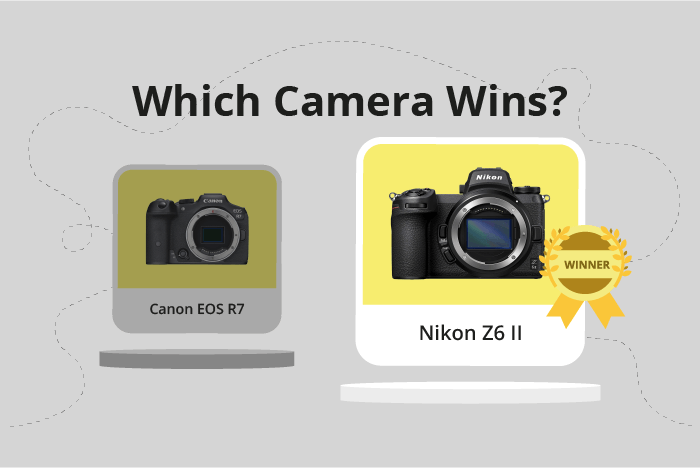Canon EOS R7 vs Nikon Z6 II Comparison
Canon EOS R7

Nikon Z6 II

The Canon EOS R7 and Nikon Z6 II both scored 83/100, making it a tie in terms of their overall performance. These mirrorless cameras share some common specifications, including their release years of 2022 and 2020, respectively.
The Canon EOS R7 stands out with its lighter weight of 612g (1.35lbs) and a more compact size of 132 x 90 x 92mm. Additionally, it offers a lower launch price of $1500, making it a more budget-friendly option for photographers.
On the other hand, the Nikon Z6 II, weighing 705g (1.55lbs) and measuring 134 x 101 x 70mm, is slightly larger and heavier. However, its higher launch price of $1995 may reflect additional features or better build quality.
Considering both cameras’ specifications and performance, it’s essential to weigh the pros and cons of each before choosing the best option for your photography needs. The Canon EOS R7’s lower price and lighter weight may be more appealing to some, while others may prefer the Nikon Z6 II for its potential additional features or superior build quality.
Canon EOS R7 vs Nikon Z6 II Overview and Optics
The Nikon Z6 II narrowly wins in the optics comparison with a score of 83/100, while the Canon EOS R7 scores 82/100. Both cameras share several common specifications, such as using a CMOS sensor, having image stabilisation, and featuring their respective lens mounts (Canon RF for the EOS R7 and Nikon Z for the Z6 II).
The Canon EOS R7 outperforms the Nikon Z6 II in certain aspects, such as having a higher megapixel count at 33 compared to the Z6 II’s 24.5, which allows for more detailed images. Additionally, the EOS R7 has a faster shooting speed of 15 frames per second (fps), compared to the Z6 II’s 14 fps, enabling the capture of fast-moving subjects more effectively. It also has a higher DXOMARK score for its sensor, at 97 versus the Z6 II’s 94, indicating better overall image quality.
However, the Nikon Z6 II has its own advantages over the Canon EOS R7. The most significant is its full-frame sensor, which is larger than the EOS R7’s APS-C sensor. This larger sensor size allows for better low-light performance and a shallower depth of field. Additionally, the Z6 II features a dual Expeed 6 processor, which may provide faster processing and better performance in certain situations.
Comparing the two cameras, the Canon EOS R7 excels in megapixels, shooting speed, and sensor score, making it a great option for those seeking high-resolution images and fast performance. On the other hand, the Nikon Z6 II’s full-frame sensor and dual processor give it an edge in low-light situations and potentially faster processing. Both cameras have their strengths, and the choice between them ultimately depends on the user’s specific needs and preferences.
Canon EOS R7 vs Nikon Z6 II Video Performance
The Canon EOS R7 and the Nikon Z6 II both have a video score of 91/100, indicating that they are equally capable in terms of video performance. They share several common specifications, including a maximum video resolution of 4K, maximum video dimensions of 3840 x 2160, a maximum video frame rate of 120fps, and built-in time-lapse functionality.
Despite the same video score, the Canon EOS R7 has some advantages over the Nikon Z6 II. These advantages, however, are not specified in the given information. To determine which camera is better, one would need to examine additional specifications or features that were not provided here.
On the other hand, the Nikon Z6 II also has some advantages over the Canon EOS R7. Again, these advantages are not specified in the given information. To determine which camera is better, one would need to examine additional specifications or features that were not provided here.
Since both cameras have the same video score and share many common specifications, it is difficult to determine a clear winner in terms of video capabilities. To make an informed decision, potential buyers should research and compare additional features and specifications not mentioned here, as well as consider factors such as price, brand preference, and compatibility with existing equipment. By doing so, one can choose the camera that best suits their needs and preferences for video performance.
Canon EOS R7 vs Nikon Z6 II Features and Benefits
The Nikon Z6 II comes out on top with a feature score of 87/100, while the Canon EOS R7 follows closely behind at 85/100. Both cameras share several key specifications, including a touchscreen, WiFi, and Bluetooth connectivity. GPS is absent in both models.
The Nikon Z6 II has a larger screen size of 3.2 inches, compared to the Canon EOS R7’s 3-inch screen. Additionally, the screen resolution of the Nikon Z6 II is higher at 2,100,000 dots, providing a sharper and clearer display than the Canon EOS R7’s 1,620,000 dots. This difference in screen size and resolution gives the Nikon Z6 II an advantage in terms of image preview and menu navigation.
On the other hand, the Canon EOS R7 has a flip screen, a feature that is not present in the Nikon Z6 II. This flip screen allows for greater flexibility when composing shots from various angles and is particularly useful for vlogging and self-portraits. Despite the smaller screen size and lower resolution, the flip screen gives the Canon EOS R7 an edge in terms of versatility.
While the Nikon Z6 II boasts a larger screen and higher resolution, the Canon EOS R7 offers a flip screen for added flexibility. Both cameras have their strengths and weaknesses, and the choice between them ultimately depends on individual preferences and priorities. If a larger screen and higher resolution are essential, the Nikon Z6 II is the better option. However, if a flip screen is a crucial feature, the Canon EOS R7 would be the preferred choice.
Canon EOS R7 vs Nikon Z6 II Storage and Battery
The Canon EOS R7 outperforms the Nikon Z6 II in storage and battery with a score of 79/100, compared to the Nikon’s 71/100. Both cameras have two memory card slots, and they accept UHS-II compatible cards. However, the Canon accepts SD, SDHC, and SDXC cards, while the Nikon takes SD, CFexpress Type B, and XQD cards.
The Canon EOS R7’s battery life is superior, offering 660 shots per charge with its LP-E6NH battery. In contrast, the Nikon Z6 II only provides 410 shots using the EN-EL15c battery. Both cameras support USB charging, adding convenience for users.
Though the Nikon Z6 II has lower battery life, it offers more versatility in memory card options, which may appeal to some users. However, the Canon EOS R7’s longer battery life makes it the better choice for extended shooting sessions or situations where charging opportunities are limited.
Canon EOS R7 vs Nikon Z6 II – Our Verdict
Are you still undecided about which camera is right for you? Have a look at these popular comparisons that feature the Canon EOS R7 or the Nikon Z6 II:

